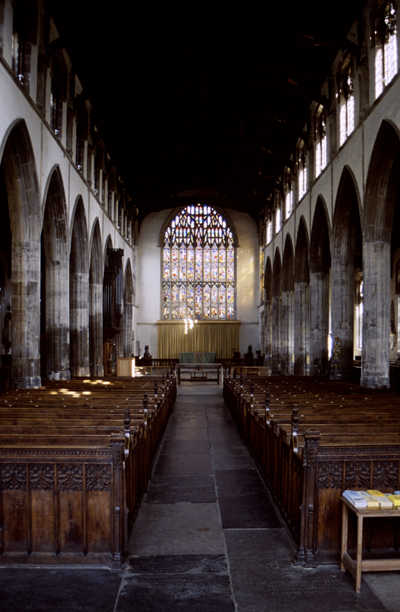 |  |  |
| St.
Nicholas' Chapel is the country's largest chapel-of-ease: a chapel dependent on a church and serving part of the parish for the convenience of parishioneres nearby. It stands to the north of the town centre in a quiet churchyard entered through a wrought iron gateway dated 1749.

It was built by William Turbus, third Bishop of Norwich(1146 - 1174) apparently to serve a new district of Lynn laid out around the new Tuesday Market place. He says: 'In our estate of Linn, in our new land which we provided recently for habitation ... we have erected a chapel in the name of St. Nicholas' * | |
|  | |
| | |
|  | |
| The
tower and spire of St Nicholas seen from St. Nicholas Street which leads out of the Tuesday Market Place | |
|  | |
|
| |
|  | |
|
| |
|
During his term as
Councillor for the Middle Ward of Kings Lynn (1835-1845), a clock for St.
Nicholas Chapel was supplied by James Saddleton, watchmaker of King's
Lynn, at a cost of £104.4.0 according to the churhwardens accounts***.

The movement was made by More & Cledawer with a 5'6" dial supplied by
James Saddleton.

I don't know if this is the present clock on the
west face of the tower. |
 |
 |
|
|
 |
|
|
The Clock face on the west face of the
tower |
| |
|  | |
|
| |
|  | |
|
| |
| The original building, dating from around 1200, was modest, its nave apparently the width of the present south aisle and its west gable with three lancet windows and a central doorway now forms the east wall of the tower (ie. that between the present church and the tower).

This new district to the north of Lynn became a very prosperous area with many rich merchants during the centuries following its establishment. | |
|  | |
| | |
|  | |
|
| |
|  | |
|
| |
| | |
|
|
 |
|
In addition to the memorial monuments inside the church, there is an
extensive graveyard around the church, with some of the gravestones still
standing but many, many others are stacked up against one another, lined up
against the south wall of the churchyard.

So far as I have been able to establish, there has been no copying of the
inscriptions on these stones. Many are still partly legible, and many others are
covered by ones in front and may (or may not) be even more legible. |
|
 |
|
| St. Nicholas from the
South East, showing some of the gravestones that still stand in the churchyard. |
|
 |
|
|
| |
| 
| |
| The registers begin in 1559 and are held, with other parish documents, on deposit at the Norfolk Record Office. | |
| 
| |
| | |
|  | |
| * quoted from St Nicholas Chapel, by Elizabeth James and Michael Begley, published by the
Churches Conservation
Trust. The other information on this page also came from that booklet which is on sale at the church. | |
|  | |
| ** E.M.Howell, A complete list of the Inscriptions on the Tablets, Slabs and Monuments in the Chapel of St Nicholas, King's Lynn (published King's Lynn 1937) - available in the
Norfolk Family History Society's Library. | |
|  | |
| *** Norfolk and Norwich Clocks and Clockmakers, edited by Clifford and Yvonne Bird, Phillimore, 1996. This book is in
Norfolk Studies Library, Norwich. | |
|  | |
|
| |
| 
photographs by Richard Ball ©
 | |
|  | |




